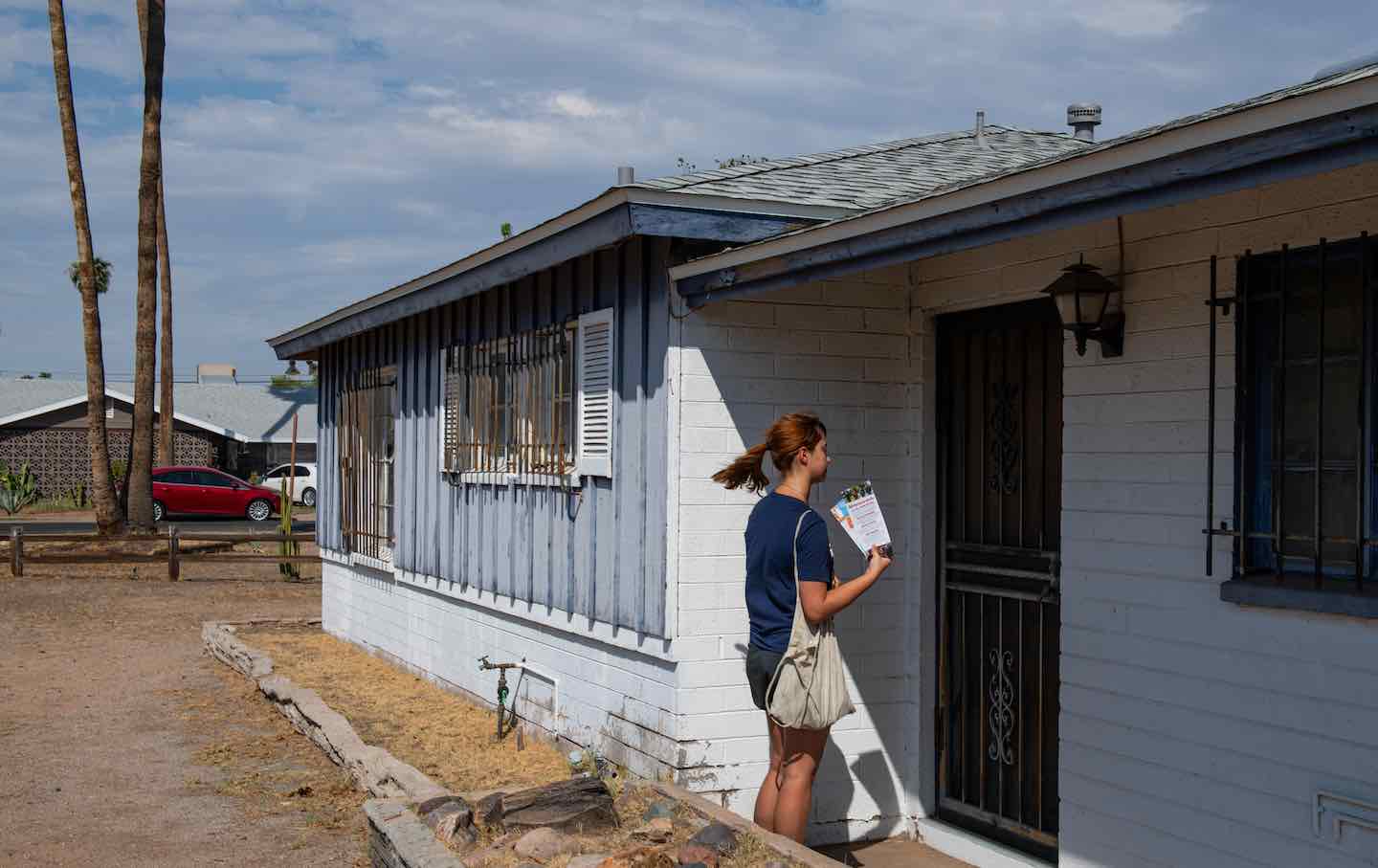There simply is no effort on the GOP side anywhere close to the size and sophistication of the Worker Power canvas.

A volunteer fans herself with political literature while canvassing for local Democrats in Phoenix, Arizona, on September 7, 2024.(Caitlin O’Hara / Bloomberg)
If the election were held tomorrow, most recent polls in Arizona suggest that Trump would narrowly win the state. It is more than possible, however, that, as was the case in the 2022 gubernatorial race—which Democrat Katie Hobbs eventually won, after she had trailed Kari Lake for much of the election season—the polls are missing some crucial below-the-surface trends.
Since July, UNITE HERE Local 11 canvassers, along with community members of the social welfare organization Worker Power, have knocked on nearly three-quarters of a million doors, many of them belonging to groups that have a low voting rate, such as young people, people of color, or poor or low-income people. It is the largest and most efficient canvas the group has ever done, says Brendan Walsh, executive director of Worker Power, who believes it is what will make a difference in the down-to-the-wire contest.
In 2020, the UNITE HERE/Worker Power canvas knocked on over 1 million doors in Arizona, and was a vital component in Biden’s effort to win the state’s 11 Electoral College votes. This time around, using sophisticated voter-outreach software to reach out to Democratic-leaning, independent, and undecided voters, they have a target of knocking on 1.3 million doors and having conversations with a quarter of a million voters. They will almost certainly surpass these numbers.
This week, Worker Power released data based on its interviews with close to 150,000 people across the state since the canvas launched in July. They found huge levels of concern around reproductive rights, especially among affluent suburban voters—and that 80 percent of voters for whom this was their number-one issue were planning to vote for Kamala Harris. They found that significant numbers of moderate, GOP-leaning voters in those suburbs—the sorts of voters for whom ex-senator Jeff Flake’s recent endorsement of Kamala Harris might actually matter—were planning to vote for Harris. And they found that among Democratic-leaning voters who said the economy was their number-one priority, most planned to vote for Harris. This finding suggests that Trump’s strategy of using economic concerns to peel off Democratic-leaning voters isn’t working out among key constituencies in the state. As importantly, given the purported power of immigration as a wedge issue in the 2024 election, the canvassers found that among the Democratic and independent voters they have contacted, it isn’t a top-three issue. It was crowded out by concerns about abortion access, the economy, and democracy.
Now, it’s possible that ultimately many of these voters, too often dismissed as “low-propensity” or “low-engagement” voters, won’t ultimately cast ballots. But over the past few election cycles canvassers for Worker Power and other groups have had marked success in turning out these voters. And, despite GOP efforts to rein in early voting, this week ballots went out to every Arizona resident. That means, Walsh explains, that “every day is now as important as Election Day.”
Given that complex reality, the ground game matters more than ever. And there simply is no effort on the GOP side anywhere close to the size and sophistication of the Worker Power canvas. “We have the tools to make a difference,” Walsh explains. “We’ve proved it in every election” over the past several cycles, helping deliver both US Senate seats to Democrats, winning the governorship and state attorney general’s office, and in 2020 delivering Arizona into Biden’s column. That year, deep in the Covid-19 pandemic, the UNITE HERE Local 11 canvassers were far-and-away the most important in-person campaign presence in an election in which most canvassing efforts had retreated online. And this time around, they have built on the knowledge honed in 2020 to launch an even bigger effort.
There are currently 250 UNITE HERE local 11 and Worker Power canvassers on the ground, most from California and Arizona, but some from as far afield as Florida, Iowa, and even another critical swing state, Pennsylvania. Many of them have been knocking on doors in Arizona since July, braving day after day of triple-digit temperatures to reach out to voters.
“When an election is within 1-to-2 percent, that’s when the fieldwork really makes the difference,” says Walsh. “I think we’re doing better than the polls reflect.”
Sasha AbramskySasha Abramsky is The Nation's Western correspondent. He is the author of several books, including The American Way of Poverty, The House of Twenty Thousand Books, Little Wonder: The Fabulous Story of Lottie Dod, the World's First Female Sports Superstar, and most recently Chaos Comes Calling: The Battle Against the Far-Right Takeover of Small-Town America. Follow him on Bluesky at @sashaabramsky.bsky.social.